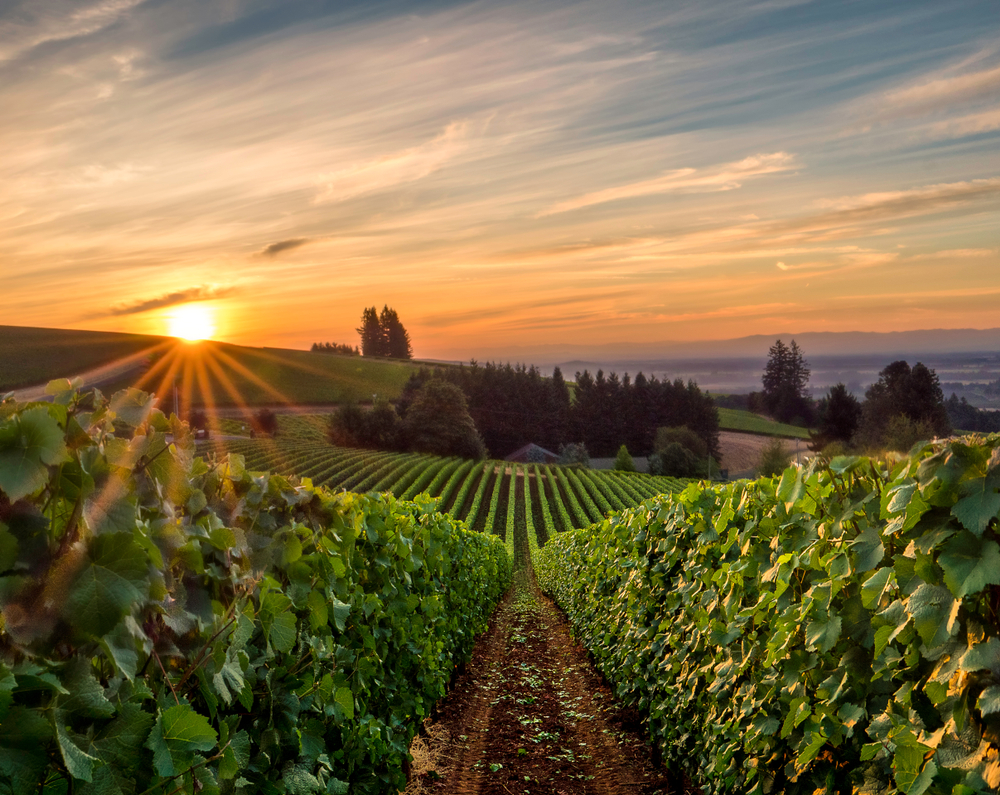The saying “If it grows together, it goes together” is often used in culinary contexts, but it also perfectly describes the relationship between Chardonnay and Pinot Noir. These two Burgundy natives thrive side by side in multiple wine regions around the world. Robb Report has observed the rise of both varieties in Oregon’s Willamette Valley over the past few years. While Pinot Noir has traditionally been the star, Chardonnay is quickly stepping into the spotlight and might soon surpass its darker counterpart in popularity. With an increasing demand for Chardonnay, many producers in Oregon are planting or grafting prized Pinot Noir blocks to accommodate this rising white varietal.
The trend isn’t just anecdotal. According to the University of Oregon’s 2022 Vineyard and Winery Report, Chardonnay acreage in Oregon has been steadily increasing: from 2,610 acres in 2020 to 2,724 acres in 2021, and up to 3,118 acres in 2022. While Pinot Noir still dominates with 26,688 acres, Chardonnay is gaining momentum, especially in the Willamette Valley. This shift is driven by both consumer demand and the realization among winemakers that some vineyard blocks are better suited for Chardonnay than Pinot Noir. At WillaKenzie Estate, Chardonnay has become a significant part of the winery’s identity. When winemaker Erik Kramer joined in 2017, there were only two acres of Chardonnay. Now, there are almost 13 acres planted.
WillaKenzie Estate’s first significant shift occurred in 2018 when Kramer grafted four acres of Pinot Noir vines over to Chardonnay in a section of the estate called Clairière. This cool, protected area has deep soils and gentle exposure, leading to excellent results. “The Chardonnay from Clairière is very good and currently the backbone for our Estate Cuvée and La Crête expressions,” Kramer tells Robb Report. The estate has since planted more Chardonnay and continues to graft portions of the vineyard to this variety. Kramer expects that the current 15 percent Chardonnay is the peak for now but acknowledges that future vineyard redevelopment might include more Chardonnay.
At Gran Moraine, which has around 150 acres of Pinot Noir and 50 acres of Chardonnay, winemaker Shane Moore notes that the Pinot Noir clone planted there was popular in the early 2000s for its ease of farming but not ideal for still wines. In recent years, they have grafted 20 acres of Pinot Noir over to Chardonnay. “The Chardonnay is performing great,” Moore says, highlighting the sedimentary soils that add tension and minerality to the wine. He believes that the vineyard could eventually shift to 150 acres of Chardonnay and only 50 acres of Pinot Noir.
The initial excitement around Pinot Noir in Willamette can be attributed to Burgundian investment, including the Drouhin family, Louis Jadot’s Résonance winery, and Nicolas-Jay, founded by Jay Boberg and Jean-Nicolas Méo. Nicolas-Jay has increased its estate plantings in the Dundee Hills AVA, from 3.5 to seven acres between 2018 and 2023, with most of the new vines being Chardonnay. “Despite an early history of up-and-down quality with Chardonnay in Oregon, the introduction of Dijon clones in the late ‘90s resulted in high-quality fruit unique to Oregon,” Boberg tells Robb Report. Although Resonance has not grafted over any Pinot Noir, they have incorporated Chardonnay into new plantings at their estate vineyards within the Dundee Hills and Yamhill Carlton AVAs and have significant Chardonnay holdings at the Koosah Vineyard in the Eola Amity Hills AVA. “Today, Résonance owns 40 acres planted with Chardonnay, all dry farmed and certified organic,” says winemaker Guillaume Large.
In conclusion, the rise of Chardonnay in Oregon’s Willamette Valley reflects a significant shift in the region’s winemaking landscape. As demand for Chardonnay grows, more winemakers are re-evaluating their vineyards and making room for this popular white varietal. This trend suggests that while Pinot Noir will always have its place, Chardonnay is poised to become a major player in Oregon’s wine industry.


